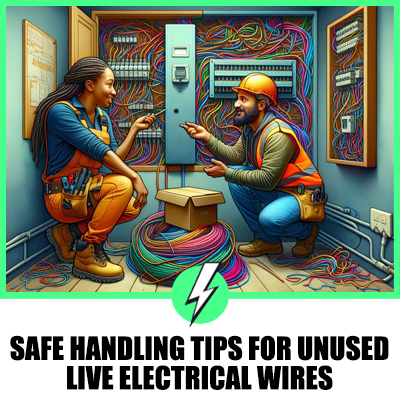Safe Handling Tips for Unused Live Electrical Wires
Ever discovered live electrical wires during a renovation or audit and wondered, “Now what?”
It’s a common puzzle homeowners encounter, and while safety is paramount, figuring out a practical solution for these wires is equally important. Whether you’re a seasoned DIYer or planning to call in the pros, knowing your options is key.
Diving into the realm of unused live electrical wires, we’ll uncover safe and practical ways to handle these unexpected finds. With the right strategy, you can address this issue confidently and efficiently, turning potential hazards into harmless, well-managed components of your home’s electrical system.
Well, we’ll be going over:
- How can you assess the risk these wires pose?
- What immediate safety precautions should you take?
- How can you identify and decide the fate of these wires?
Let’s get started!

Contents
Assessing the Risk of Unused Live Electrical Wires
When you stumble upon unused live electrical wires in your home, it’s crucial to assess their risk immediately.
These wires, if not handled properly, can pose significant dangers including electrical shocks and fire hazards.
Understanding the potential risks associated with these wires is your first step towards ensuring a safe environment.
First, identify if the wire is indeed live. You can use a non-contact voltage tester for this purpose.
If the tester indicates the presence of voltage, you’re dealing with a live wire. This discovery warrants caution; live wires are unpredictable and can cause harm if touched or handled improperly.
Next, ascertain the wire’s purpose. Sometimes, wires are left live because they serve future expansion needs or were part of a previous installation that’s no longer in use.
Knowing the wire’s intended purpose helps in making an informed decision about how to proceed.
It’s also important to check for any signs of wear and tear. Damaged insulation or exposed wire strands significantly increase the risk of accidents. If any damage is spotted, the urgency to address the situation escalates.
By diligently assessing these factors, you’ll gain a clear understanding of the potential risks and necessary precautions when dealing with unused live electrical wires.
This knowledge is pivotal in navigating the next steps, whether it’s opting for a DIY fix or calling in professional help.
Safety Precautions to Take Immediately
When you discover unused live electrical wires during renovations or audits, your immediate response should prioritise safety.
First and foremost, do not touch these wires under any circumstances. The potential for electrical shocks is high and can result in severe injuries or even fatalities.
Ensure the power is turned off at the main breaker before proceeding. This is a critical step in avoiding any accidental electrical discharges.
If you’re unsure about which breaker controls the area you’re working in, it’s safer to turn off power to the entire property.
After ensuring the area is safe to work in, label the wires clearly. Use a voltage tester to confirm whether the wires are live and then tag them accordingly.
This not only helps you but also warns others who might come into contact with these wires in the future.
Lastly, wear appropriate protective gear. Rubber-soled shoes, insulated gloves, and protective eyewear are essential to minimise risk while handling or being near electrical wires.
This gear provides an additional layer of protection against potential electrical hazards.
Identifying the Source and Purpose of the Wires
After ensuring your immediate safety when dealing with unused live electrical wires, your next step is to pinpoint their source and intended function.
This is vital in determining whether the wires can be safely removed, retained, or repurposed. Initially, trace the wires back to their origin.
This might be a challenge, particularly in older buildings where wiring systems can be complex and not well-documented.
Mapping the electrical system is a proactive approach. If available, consult the building’s electrical schematic or circuit diagram. Unfortunately, this documentation isn’t always accessible.
In such cases, you might need to employ a circuit tracer, a tool that, when used correctly, can lead you to the circuit breaker or fuse controlling the specific wires in question.
Understanding the purpose of these wires is equally crucial. Are they meant for lighting, outlets, or perhaps a now-obsolete type of machinery?
Knowing this will help you make an informed decision on how to proceed. If you’re unsure, or if the task seems beyond your skill set, don’t hesitate to contact a professional electrician.
They can provide insights and solutions that ensure your safety and compliance with local electrical codes.
Options for Managing and Disposing of Unused Live Wires
Once you’ve identified and ensured the safety of unused live wires, it’s vital to decide on the next steps.
Proper management and disposal are crucial to maintaining safety and compliance with local regulations.
- Cap and Label: If there’s a chance you’ll need the wires in the future, capping them with wire nuts and labelling their purpose is a wise choice. This keeps them safe and identified for future use.
- Remove or Repurpose: When sure you won’t need the wires, consider removing them completely or repurposing them for other electrical needs. However, this should be done by a professional to avoid damage to your home’s electrical infrastructure.
- Professional Disposal: For wires that are no longer needed, or if you’re unsure about how to safely manage them, contacting a certified electrician for disposal is your best bet. They can remove the wires safely and ensure that your electrical system remains compliant with all safety standards.
Remember, dealing with electrical systems requires knowledge and caution. If you’re ever in doubt, seeking professional advice isn’t just recommended, it’s necessary.
Consulting Professionals for Assistance
Dealing with unused live electrical wires isn’t just about adherence to safety protocols; it’s about ensuring the job is done right.
Consulting professionals for assistance ensures that any action taken on these wires is both safe and compliant with current regulations.
Professional electricians have the knowledge, expertise, and tools necessary to assess your situation accurately and provide tailored solutions.
When you’re unsure about the steps to take with unused live electrical wires, a certified electrician can be your go-to resource.
They can identify whether the wires can be safely repurposed, require removal, or can be left in place safely with appropriate measures.
Moreover, professionals can offer insights into the most current safety standards and help you navigate any permits or approvals required by your local authority.
Remember, electrical work poses significant risks, and professional advice or intervention is not just a recommendation—it’s a necessity for ensuring safety and compliance.
Conclusion
Tackling unused live electrical wires isn’t a DIY project. It’s crucial to prioritize safety and compliance by seeking professional help.
Electricians have the expertise to provide the best course of action, ensuring your peace of mind. Remember, handling electrical wires without the right knowledge can be dangerous.
So, don’t take risks with your safety or compliance. Reach out to a professional electrician today and address those unused live wires the right way.





